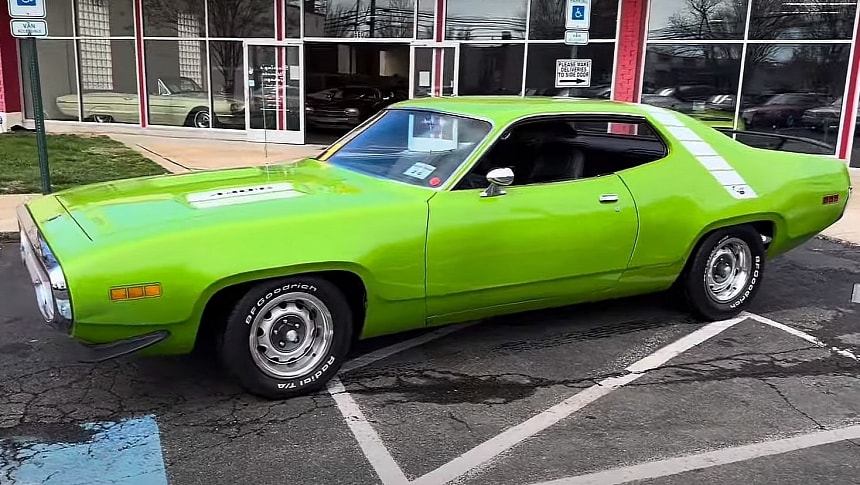Introduced in 1968 as Plymouth's most affordable muscle car, the Road Runner soldiered on through 1980. However, the nameplate lost its stand-alone model status in 1976 when it became a trim package for the Volare. And like all Mopars, the Road Runner lost its high-compression V8 engines at the end of the 1971 model year.
All told, it's the late 1960s and early 1970s versions that get all the attention nowadays. And while the 383-cubic-inch (6.3-liter) cars are rather common, the 440-cubic-inch (7.2-liter) Six-Pack and 426-cubic-inch (7.0-liter) HEMI rigs are rare and highly sought after.
Speaking of which, the 1971 Road Runner is the rarest iteration of the high-compression cars. Plymouth sold 13,668 units that year, a dramatic drop from the 36,861 examples sold in 1970. It's also a tiny fraction of 1969 sales, which came in at a whopping 81,105 cars.
Most customers went with the four-barrel 383 V8 in 1971. Specifically, about 85.4% of the Road Runner delivered that year rolled off the assembly line with this mill. The newly introduced 340-cubic-inch (5.6-liter) small-block was the next most popular engine with 1,681 units (about 12.3%). This leaves only 2.2% of the 1971 Road Runners fitted with the 440 Six-Barrel and the 426 HEMI.
The latter found its way into only 55 examples, while the former powered 246 rigs. Needless to say, both are scarce enough to command six-figure sums at public auctions. The Road Runner you see here is not one of those cars, but it packs more oomph than a factory 1971 Plymouth, thanks to a beefed-up 440 V8.
Although it looks like a Six-Barrel car at first glance, this Road Runner most likely rolled off the assembly line with a different engine. My bet is on the 383 V8 since the big-block four-barrel was very common that year. The sticker is also too low for an original 440-6 automatic (just 109 made) at $59,990. Unfortunately, the ad does not list the VIN.
But while it may not be an authentic Six-Barrel car, this Road Runner is no slouch. The six-barrel unit under the hood had been rebuilt with high-performance parts, and it now cranks out 450 horsepower. That's a solid 60 horses over the 1971 440 Six-Barrel engine. Moreover, this Road Runner is potent enough to leave a true-blue HEMI vehicle behind (these came with 425 horsepower on tap).
Performance-aside, this Road Runner is also an incredibly beautiful machine. It's finished in a spotless layer of Sassy Grass (FJ6 was offered in 1970 and 1971) and boasts all the correct Road Runner markings. The cabin sports a few features you wouldn't normally see in a 1971 car, but most of the layout is true to this year's B-body.
Finally, the beefed-up Six-Barrel V8 sounds gorgeous, and you can find out more about it in the video below.
Speaking of which, the 1971 Road Runner is the rarest iteration of the high-compression cars. Plymouth sold 13,668 units that year, a dramatic drop from the 36,861 examples sold in 1970. It's also a tiny fraction of 1969 sales, which came in at a whopping 81,105 cars.
Most customers went with the four-barrel 383 V8 in 1971. Specifically, about 85.4% of the Road Runner delivered that year rolled off the assembly line with this mill. The newly introduced 340-cubic-inch (5.6-liter) small-block was the next most popular engine with 1,681 units (about 12.3%). This leaves only 2.2% of the 1971 Road Runners fitted with the 440 Six-Barrel and the 426 HEMI.
The latter found its way into only 55 examples, while the former powered 246 rigs. Needless to say, both are scarce enough to command six-figure sums at public auctions. The Road Runner you see here is not one of those cars, but it packs more oomph than a factory 1971 Plymouth, thanks to a beefed-up 440 V8.
Although it looks like a Six-Barrel car at first glance, this Road Runner most likely rolled off the assembly line with a different engine. My bet is on the 383 V8 since the big-block four-barrel was very common that year. The sticker is also too low for an original 440-6 automatic (just 109 made) at $59,990. Unfortunately, the ad does not list the VIN.
But while it may not be an authentic Six-Barrel car, this Road Runner is no slouch. The six-barrel unit under the hood had been rebuilt with high-performance parts, and it now cranks out 450 horsepower. That's a solid 60 horses over the 1971 440 Six-Barrel engine. Moreover, this Road Runner is potent enough to leave a true-blue HEMI vehicle behind (these came with 425 horsepower on tap).
Performance-aside, this Road Runner is also an incredibly beautiful machine. It's finished in a spotless layer of Sassy Grass (FJ6 was offered in 1970 and 1971) and boasts all the correct Road Runner markings. The cabin sports a few features you wouldn't normally see in a 1971 car, but most of the layout is true to this year's B-body.
Finally, the beefed-up Six-Barrel V8 sounds gorgeous, and you can find out more about it in the video below.










